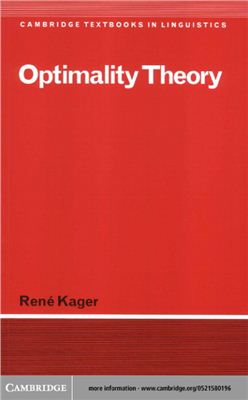Cambridge University Press, 1999 - Всего страниц: 452
This is an introduction to Optimality Theory, whose central idea is that surface forms of language reflect resolutions of conflicts between competing constraints. The book does not limit its empirical scope to phonological phenomena, but also contains chapters on the leaability of OT grammars; OT's implications for syntax; and other issues such as opacity. Exercises accompany chapters 1-7, and there are sections on further reading. Optimality Theory will be welcomed by any linguist with a basic knowledge of derivational Generative Phonology.
This is an introduction to Optimality Theory, whose central idea is that surface forms of language reflect resolutions of conflicts between competing constraints. The book does not limit its empirical scope to phonological phenomena, but also contains chapters on the leaability of OT grammars; OT's implications for syntax; and other issues such as opacity. Exercises accompany chapters 1-7, and there are sections on further reading. Optimality Theory will be welcomed by any linguist with a basic knowledge of derivational Generative Phonology.

